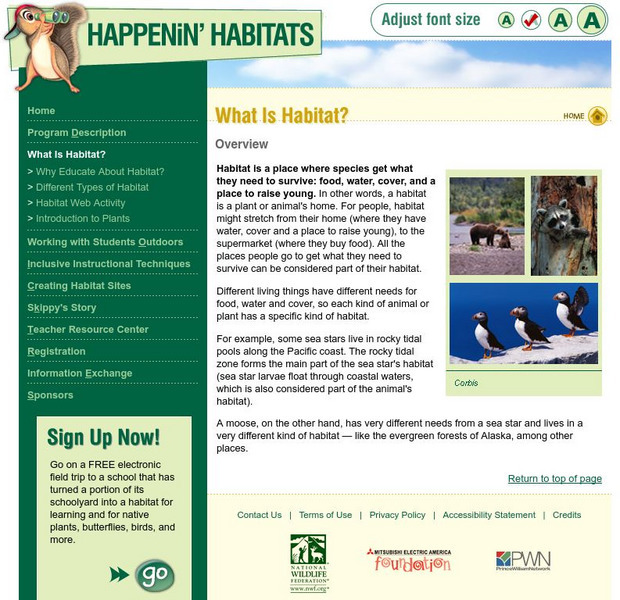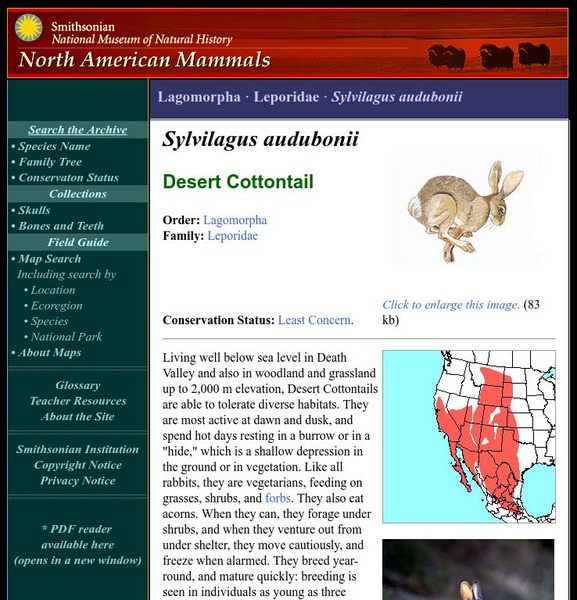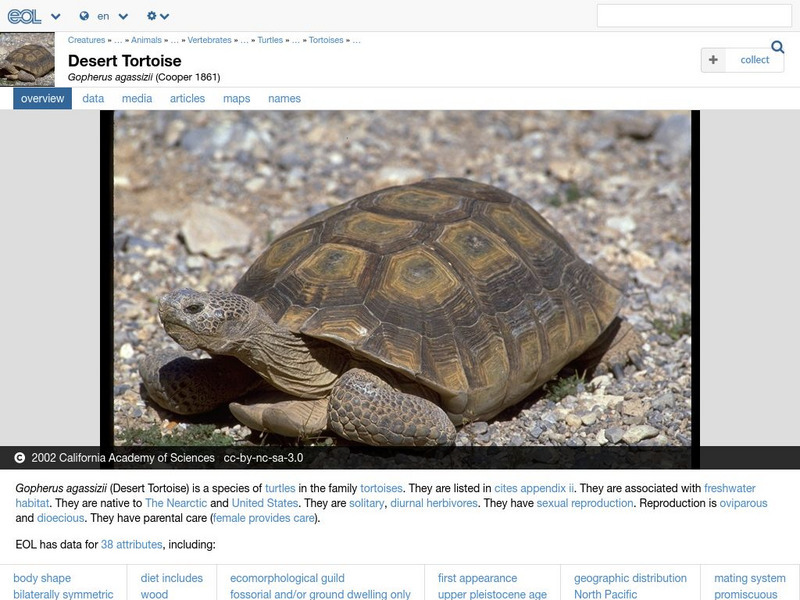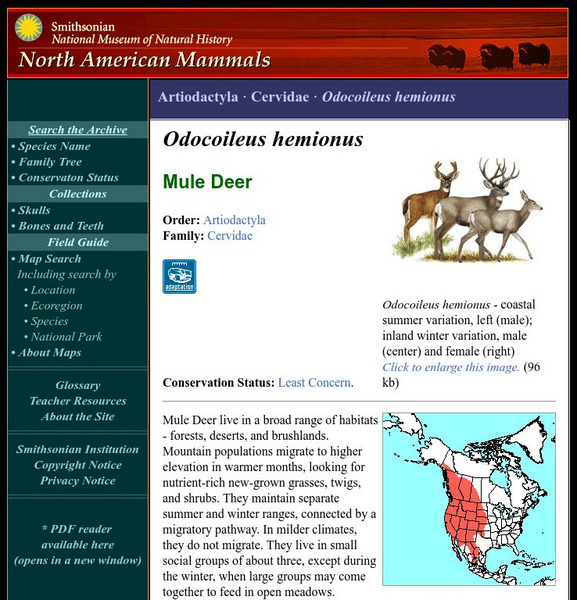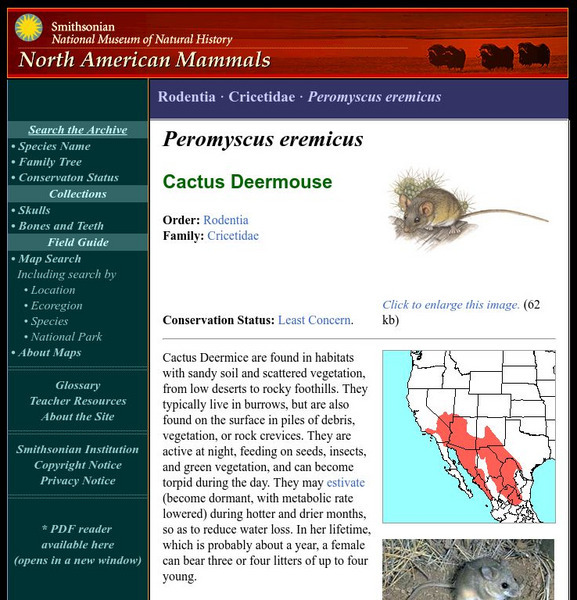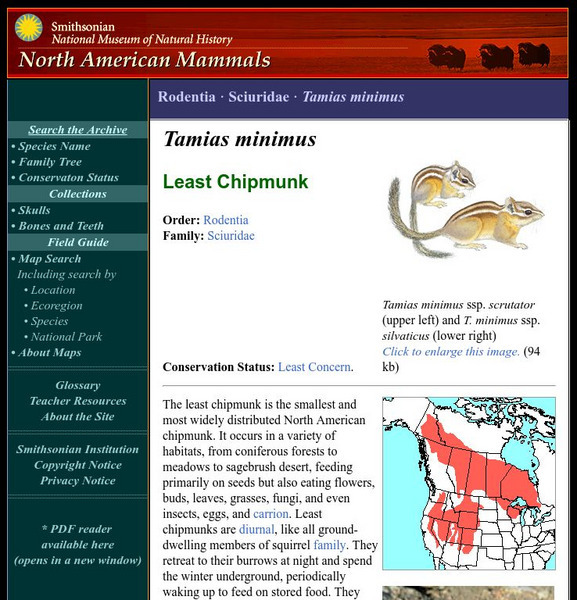Hi, what do you want to do?
Enchanted Learning
Enchanted Learning: Biomes
Discover the hidden treasures in the different habitats on the earth! The earth is filled with many biomes. Examples of different biomes are listed and include hyperlinks to additional information such as the animals found there.
PBS
Pbs Learning Media: Teri and Jairus: Biome Buddies
This video segment from ZOOM compares and contrasts the habitat and life forms found in Death Valley with those found in the temperate rain forest of the Pacific Northwest. [3:46]
Other
National Wildlife Federation: Happenin' Habitats: What Is Habitat?
Find an overview of what a habitat is exactly. Then, for more information, click in the left hand menu for different types of habitat: forests, grasslands, deserts, wetlands, and arctic tundra. Authors also offer advice on creating a...
TeachEngineering
Teach Engineering: Computer Simulation of the Sonoran Desert Community
The computer program's simulation of a Sonoran desert community should ultimately strengthen the student's comprehension of what is required for a natural ecosystem to sustain itself (remain in balance). This computer simulation program...
PBS
Pbs Kids: Plum Landing: Can You Dig It?
Set in the Australian desert, players become bilbies to search at night for food while looking out for hungry predators like dingos, foxes, and swooping eagles.
Smithsonian Institution
National Museum of Natural History: American Mammals: Desert Cottontail
Living well below sea level in Death Valley and also in woodland and grassland up to 2,000 m elevation, Desert Cottontails are able to tolerate diverse habitats. They are most active at dawn and dusk and spend hot days resting in a...
Geographypods
Geographypods: Introduction to Ecosystems and Biomes
Using worksheets, images, videos, and internet resources, students will be able to learn the names and locations of the seven major global biomes in the correct order from polar regions to the equator.
Encyclopedia of Life
Encyclopedia of Life: Desert Tortoise
The Encyclopedia of Life presents this in-depth overview of Desert Tortoises (Gopherus agassizii), including their habitats, size, conservation status, and much more. Images of this species and maps of its global distribution can also be...
PBS
Pbs Learning Media: Biomes
This interactive resource adapted from NASA describes the different temperature, precipitation, and vegetation patterns in seven biomes: coniferous forest, temperate deciduous forest, desert, grassland, rainforest, shrubland, and tundra.
Globio
Glossopedia: Environments
This article defines "environment" as a collection of animals and plants in a specific landscape and climate. The concept of differing types of environments is introduced. The impact of humans on environments and all environments'...
Houghton Mifflin Harcourt
Harcourt: School Publishers: Exploring Ecosystems
Compare and contrast three very different ecosystems - the Sonoran Desert in Arizona, the Florida Everglades, and the Arctic Coastal Plain in Alaska. Learn what makes each of them unique, and about the adaptations plants and animals had...
Smithsonian Institution
National Museum of Natural History: American Mammals: Southwestern Myotis
Southwestern myotis live in a variety of southwestern mountain habitats, from desert grasslands up into pine and mixed coniferous forest in the United States, and in desert and grassland in Mexico. These bats and two other myotis...
Smithsonian Institution
National Museum of Natural History: American Mammals: San Diego Pocket Mouse
The San Diego Pocket Mouse occurs in desert and coastal habitats in southern California, Mexico, and northern Baja California, from sea level to at least 1,400 m. Yellowish or orange hair on its sides contrasts with a dark brown back,...
Smithsonian Institution
National Museum of Natural History: American Mammals: Mule Deer
Mule Deer live in a broad range of habitats - forests, deserts, and brushlands. Mountain populations migrate to higher elevation in warmer months, looking for nutrient-rich new-grown grasses, twigs, and shrubs. Learn more about the...
Smithsonian Institution
National Museum of Natural History: American Mammals: Western Pipistrelle
Western pipistrelles sometimes leave their roosts before sundown and can be mistaken for late-flying butterflies, because they are so tiny and fly slowly and erratically, with much fluttering of their wings. Most common at low elevations...
Smithsonian Institution
National Museum of Natural History: American Mammals: Cactus Deermouse
Cactus Deermice are found in habitats with sandy soil and scattered vegetation, from low deserts to rocky foothills. They typically live in burrows but are also found on the surface in piles of debris, vegetation, or rock crevices. Learn...
Smithsonian Institution
National Museum of Natural History: American Mammals: Least Chipmunk
The least chipmunk is the smallest and most widely distributed North American chipmunk. It occurs in a variety of habitats, from coniferous forests to meadows to sagebrush desert, feeding primarily on seeds but also eating flowers, buds,...







